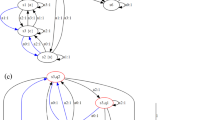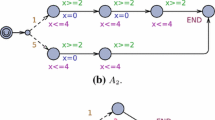Abstract
We present a verification algorithm for duration properties of real-time systems. While simple real-time properties constrain the total elapsed time between events, duration properties constrain the accumulated satisfaction time of state predicates. We formalize the concept of durations by introducing duration measures for timed automata. A duration measure assigns to each finite run of a timed automaton a real number —the duration of the run— which may be the accumulated satisfaction time of a state predicate along the run. Given a timed automaton with a duration measure, an initial and a final state, and an arithmetic constraint, the duration-bounded reachability problem asks if there is a run of the automaton from the initial state to the final state such that the duration of the run satisfies the constraint. Our main result is an (optimal) PSPACE decision procedure for the duration-bounded reachability problem.
Similar content being viewed by others
References
R. Alur, C. Courcoubetis, and D.L. Dill, “Model checking in dense real time,” Information and Computation, Vol. 104, No. 1, pp. 2-34, 1993.
R. Alur, C. Courcoubetis, N. Halbwachs, T.A. Henzinger, P.-H. Ho, X. Nicollin, A. Olivero, J. Sifakis, and S. Yovine, “The algorithmic analysis of hybrid systems,” Theoretical Computer Science, Vol. 138, pp. 3-34, 1995.
R. Alur and D.L. Dill, “A theory of timed automata,” Theoretical Computer Science, Vol. 126, pp. 183-235, 1994.
R. Alur, T. Feder, and T.A. Henzinger, “The benefits of relaxing punctuality,” Journal of the ACM, Vol. 43, No. 1, pp. 116-146, 1996.
R. Alur and T.A. Henzinger, “Logics and models of real time: a survey,” In J.W. de Bakker, K. Huizing, W.-P. de Roever, and G. Rozenberg, editors, Real Time: Theory in Practice, Lecture Notes in Computer Science 600, pp. 74-106. Springer-Verlag, 1992.
R. Alur, T.A. Henzinger, and P.-H. Ho, “Automatic symbolic verification of embedded systems,” IEEE Transactions on Software Engineering, Vol. 22, No. 3, pp. 181-201, 1996.
A. Bouajjani, R. Echahed, and J. Sifakis, “On model checking for real-time properties with durations,” In Proceedings of the Eighth Annual Symposium on Logic in Computer Science, pp. 147-159. IEEE Computer Society Press, 1993.
E.M. Clarke and E.A. Emerson, “Design and synthesis of synchronization skeletons using branching-time temporal logic,” In Workshop on Logic of Programs, Lecture Notes in Computer Science 131. Springer-Verlag, 1981.
K. Cerāns, “Decidability of bisimulation equivalence for parallel timer processes,” In G. von Bochmann and D.K. Probst, editors, CAV 92: Computer-aided Verification, Lecture Notes in Computer Science 663, pp. 302-315. Springer-Verlag, 1992.
Z. Chaochen, C.A.R. Hoare, and A.P. Ravn, “A calculus of durations,” Information Processing Letters, Vol. 40, No. 5, pp. 269-276, 1991.
C. Courcoubetis and M. Yannakakis, “Minimum and maximum delay problems in real-time systems,” In K.G. Larsen and A. Skou, editors, CAV 91: Computer-aided Verification, Lecture Notes in Computer Science 575, pp. 399-409. Springer-Verlag, 1991.
D.L. Dill, “Timing assumptions and verification of finite-state concurrent systems,” In J. Sifakis, editor, CAV 89: Automatic Verification Methods for Finite-state Systems, Lecture Notes in Computer Science 407, pp. 197-212. Springer-Verlag, 1989.
T.A. Henzinger, P.W. Kopke, A. Puri, and P. Varaiya, “What's decidable about hybrid automata?” In Proceedings of the 27th Annual Symposium on Theory of Computing, pp. 373-382. ACM Press, 1995.
T.A. Henzinger, Z. Manna, and A. Pnueli, “What good are digital clocks?” In W. Kuich, editor, ICALP 92: Automata, Languages, and Programming, Lecture Notes in Computer Science 623, pp. 545-558. Springer-Verlag, 1992.
T.A. Henzinger, X. Nicollin, J. Sifakis, and S. Yovine, “Symbolic model checking for real-time systems,” Information and Computation, Vol. 111, No. 2, pp. 193-244, 1994.
Y. Kesten, A. Pnueli, J. Sifakis, and S. Yovine, “Integration graphs: a class of decidable hybrid systems,” In R.L. Grossman, A. Nerode, A.P. Ravn, and H. Rischel, editors, Hybrid Systems, Lecture Notes in Computer Science 736, pp. 179-208. Springer-Verlag, 1993.
J. Queille and J. Sifakis, “Specification and verification of concurrent systems in CESAR,” In M. Dezani-Ciancaglini and U. Montanari, editors, Fifth International Symposium on Programming, Lecture Notes in Computer Science 137, pp. 337-351. Springer-Verlag, 1981.
Author information
Authors and Affiliations
Rights and permissions
About this article
Cite this article
Alur, R., Courcoubetis, C. & Henzinger, T.A. Computing Accumulated Delays in Real-time Systems. Formal Methods in System Design 11, 137–155 (1997). https://doi.org/10.1023/A:1008626013578
Issue Date:
DOI: https://doi.org/10.1023/A:1008626013578




